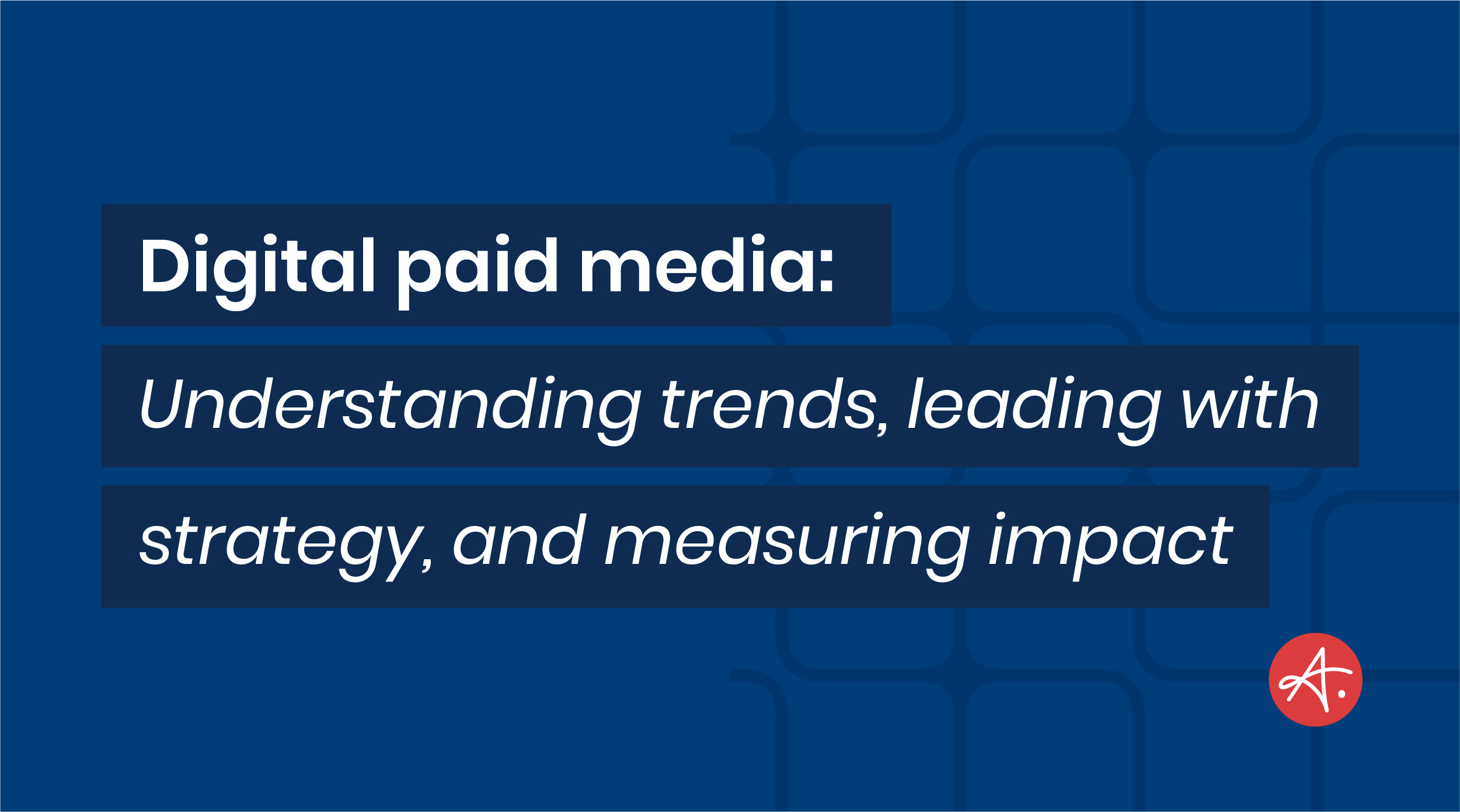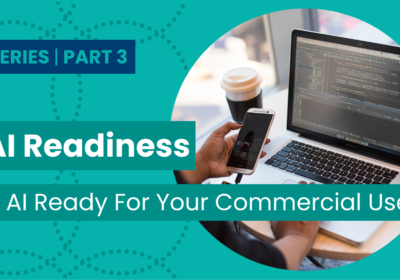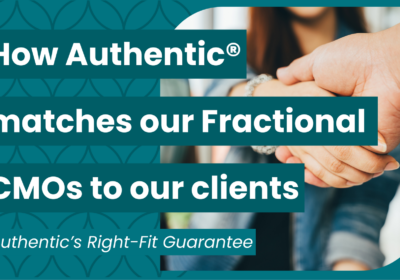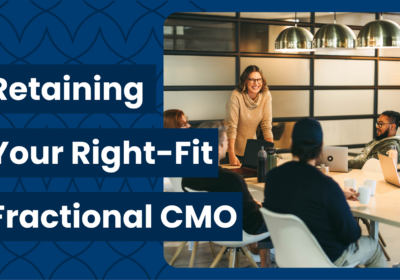
The landscape of paid digital media can be tricky for businesses to understand and navigate. It seems new trends emerge daily (ChatGPT, Google’s Performance Max campaigns, a cookieless world), making it difficult to stay on top of the best channels, tactics, and approaches. Plus, without a solid strategy, companies can quickly burn through money with little return.
We invited two of Authentic’s fractional CMOs, Veronica Williams and Dee Heffernan, and one of our Ally Network providers, Kyle Mealy of Rocket Clicks, to discuss paid digital media. They share insights on emerging trends and how to make sense of the tactics available, build a paid media plan that supports your marketing strategy, and ensure your investments are paying off.



- Let’s take a moment to level set with Kyle, a paid media expert. There are some significant trends impacting the paid media landscape. Can you share some of these trends with us, and how businesses can navigate them?
Kyle: We’re tracking three major trends in the paid media landscape: 1) the evolution of AI both in platform (Google’s PMax) and off platform (ChatGPT), 2) surviving a cookieless world, and 3) the rising paid media costs and reduced effectiveness.
With one command, you can now leverage ChatGPT’s AI content writing to develop 10 Google Ad headlines relevant to your product. PMax takes the assets you give and it will go find conversions for you. What does this all mean? Building good ads no longer costs time or talent like it used to. It means that competitors can catch up to the same quality of advertising you’ve spent 3 or 4 years developing. Iterative testing becomes near instantaneous since you are no longer limited by a talented person developing ad copy and executing campaigns to display that ad copy.
The cookieless world is causing a decline in our ability to trace dollars in and dollars out to the campaign level. Last-click attribution is getting more gray than black and white. Incrementality and net new revenue relative to advertising dollars are going to be more earnest measurements of success. While the major platforms (Google/Facebook/Instagram) are obviously financially motivated to find workarounds, you can find hidden, smart conversation opportunities if you know what data to capture and what data to feed back into the algorithms.
With 80% of businesses on search, advertising has never been easier, and the mentality of “build it and the revenue will come” still exists. What does that mean? There’s lots of competition for a marketplace that is shrinking. It doesn’t take an economics degree to understand that increased competition (and being easier to compete — looking at you PMax) means prices will go up and returns will go down.
The real opportunity is to understand that search is changing. Alexa is starting to eat up kitchen searches (e.g., “how many teaspoons are in a ¼ cup?”). Reddit is where people go for context. User-generated content on YouTube comparing and contrasting an array of hiking boots is a mid-level search! First-mover advantage and thinking outside of the big platforms is the next win.
- One more for you, Kyle: What essential tactics and channels should businesses keep in mind when charting their paid media strategy? How does a business determine where to allocate its paid media investments?
Kyle: Understanding your buyer and the journey they take to you is the first step in crafting a paid media strategy. The next step is to understand what problem your paid media needs to solve.
Let’s say you need to create visibility — you need to be found right away by customers. For example, most people don’t have a “go-to” locksmith. If you need one, you need to find one that looks trustworthy quickly. Most likely, you will do a Google search to find one. Because of this, locksmiths need to be found immediately on Google. Winning on Google likely means investing in Google Ads and local SEO. Locksmiths are going to lose money if they’re instead spending on Facebook.
Another problem your paid media might need to solve is awareness. Is your product a novel innovation, a “better than sliced bread” item that solves a problem that most of us don’t even realize we have? Here’s an example of a product that hit it for me: An angled shower curtain for tall and hairy people. For anyone tall, or people with lots of hair (of which I am neither), elbows running into shower curtains is annoying. Did you know there is a product made to solve that?
Products like these need to be “seen” to get sold. But it’s getting you to see it that causes the real issue. No one searches for an angled shower curtain. No one is trying to have ad coverage of “shower curtains for tall people.” But if you target visitors to websites that serve “big and tall” clothing products with an awareness campaign, you might net yourself an interested buyer.
- Dee and Veronica, from your experience as marketing leaders, how have you seen paid media effectively support a company’s larger marketing strategy? When does it make sense for companies to implement a paid media plan?
Dee: First, we need to acknowledge the obvious. Deciding to “throw some money at paid ads and see what happens” isn’t a strategy. Unfortunately, this is about as far as most first-time paid media advertisers get when they first take the plunge and realize that paid media is not a set-it-and-forget-it marketing tactic. And for many, this can be an expensive education.
Paid advertising is designed to be a powerful tool for reaching new customers, increasing brand awareness, and driving sales. Businesses can also use it to support specific marketing campaigns or promotions, such as a new product launch or a seasonal sale. One of the best things about it is that there’s no set dollar amount you need to spend in order to build an effective strategy. You can turn it on and off as needed, controlling the spend as you optimize your strategy over time and see real-time results, allowing you to change direction on a dime.
By using paid media in conjunction with other marketing tactics, such as content marketing, email marketing, and search engine optimization, a company can create a holistic marketing strategy that is as nimble as it is targeted.
Veronica: Assuming there is a marketing strategy, it will define your target audience and describe the customer’s journey: what type of content or information are they looking for as they move through their decision making process and where will they expect to find that information. If paid media is the best way to reach your target audience, that’s a good time to add it.
Dee makes a great point: paid media can be a very effective way to help prospects find you in the awareness stage. And it can help them find important information during the research phase or alert them to specific solutions during the selection process, too.
Understanding where your customer is in their journey when they engage with your paid media informs how you’ll measure its effectiveness. When running an ad designed to attract attention during the awareness phase, impressions might be a valuable KPI, but the KPI you’ll use for evaluating an ad in the selection stage will be very different.
- Dee and Veronica, we’d love to hear some examples of how you’ve helped businesses use paid media to support their growth. Is paid media particularly compelling for certain types of businesses or industries?
Veronica: B2B consumers are already 57% down their decision-making path before they’ll take an action on your website. And 81% of retail shoppers conduct research online before making a purchase. With numbers like that, it’s safe to say that digital marketing is critical regardless of your vertical, and paid media can be an important part of that mix.
I’ve used paid media successfully to drive awareness and sales for a D2C client, and I’ve also had good success using it for hospitality, B2B, and financial services. But, I’ve always used paid media as part of an omnichannel approach. I’ve heard stories from clients who had invested a lot in paid media as their only tactic and that rarely works. You also have to ensure there isn’t a disconnect between your paid media and your on-site experience. For example, if you create landing pages outside of your marketing ecosystem, you could end up with a disjointed user experience, and that’ll have a negative effect on the results.
Dee: Anyone who’s ever been served an ad for a product you were talking to a friend about at dinner knows that consumers are the biggest targets of paid advertising. Once you’ve made it into a brand’s ecosystem, your data becomes useful. Any business that understands the value of this is poised to benefit from paid media.
As a fractional CMO and brand strategist, I’ve helped businesses of all sizes incorporate paid media to support their growth. First, by identifying and understanding the target audience, and then by designing experiences throughout the client’s channel mix (e.g., website, social media) where visitors could have their needs met while also being enticed to engage further (e.g., fill out a form, download a pdf, join the email list, sign up for a product) with the brand.
I’ve used paid media to launch line extensions for a heavily DTC brand, using a combination of broad brand awareness ads and more targeted purchase-conversion ads. Working with an agency partner that specialized in digital paid media advertising was a game-changer for us when it came to determining which KPIs we were measuring for, and importantly, how our in-house creative team needed to tailor ads for specific platforms and target audiences.
- Now for the big question executives always want the answer to: Could everyone weigh in on how businesses can measure ROI to determine whether their paid media efforts are working?
Veronica: If you understand where in the customer journey you’re using your ad to engage with your prospects, it’s a lot easier to define how you’ll measure your return on investment. It may not always be dollars out versus dollars in. Money invested in brand building is often seen as having the lowest ROI. Yet when you consider the impact that brand reputation has on your ability to influence the price of your product, it is one of the most valuable investments you can make.
Back in the 1990s, McKinsey & Co. showed that a 1% increase in price translated into an 11% increase in profits, while a 1% increase in volume only resulted in a 3.3% increase. Remember my D2C example from above? Within a two-year period, our cost of manufacturing almost doubled. Yet when we doubled our price, sales continued to grow, even with a 1-year waitlist for our product. A strong brand helps you warrant a price increase, which is a significant profit driver.
Kyle: Creating clear data systems for sales and revenue growth relative to marketing spend will be critical in building a more holistic understanding of paid media ROI. The days of pumping more dollars into winning campaigns to create more ROI are fading. The reality is that your buyers interact with your product in many different ways, and we can’t be certain which touch point moves them toward purchase. But we can track the flow of dollars in relative to the dollars out.
For example, you can test whether adding more dollars to top-of-funnel efforts creates a downstream impact of net new direct users. That could be seen as a win. Or see if direct users convert at a higher rate when you increase your top-of-funnel paid media budgets.
Dee: I love Veronica’s stats on the value of directing ad spend toward building a strong brand reputation – which can lead to increased customer loyalty, positive word-of-mouth, and greater long-term profitability.
And to Kyle’s point, understanding what drive’s ROI requires a full-funnel lens. Getting clicks is a great first indicator that an ad campaign is compelling. But who’s making those clicks? Are they customers likely to convert? Or are they window shoppers following a shiny object?
I like to look at the points along the funnel where users drop off, and also where they click further into the funnel. By optimizing each interaction along a marketing funnel, companies can provide a better customer experience, eliminate bottlenecks and reduce waste in marketing efforts, make data-driven decisions, and ultimately drive the kinds of higher conversion rates that increase not only revenue — but profits.
Understand trends while focusing on strategy fundamentals
Significant trends are impacting how brands will succeed with digital paid media. Having a grasp of these trends and their impacts is critical. Yet, marketing success still relies on the strength of a company’s holistic marketing strategy — and how marketers weave paid media and other tactics into that.
Authentic prioritizes continued learning for our CMOs, so they stay sharp on significant trends. But we also ensure our clients have the pieces in place to develop maturity across their entire marketing ecosystem. Businesses looking to invest in paid media first need a marketing strategy that considers the target audience(s), its buyer’s journey, and how best to reach and support them along that journey. Let’s connect if you’d like to discuss how one of our fractional CMOs can help your business develop a paid media plan aligned with a strategy that supports your healthy growth.








